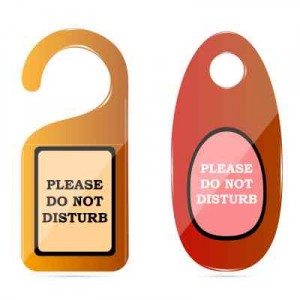
It seems these days internet ads get high click-through rates if they start with “Weird trick.” I’m game. For patient centered care, the weird trick is to think about this:
Listen to what matters to patients (ask them),
and decide that it matters to you.
You’ll see things from their point of view,
and you’ll become patient centered.
I know it’s weird, but think: when patients tell you something’s bothering them, do you say “Sorry, there’s nothing we can do about it”? That’s the hallmark of being disempowered. Or do you do something about it? Or as your team to see if you can?
For instance, noise: I just learned that some hospitals are letting people put up a Do Not Disturb sign! Hard to imagine? It’s in a great Wall Street Journal piece yesterday by Laura Landro.
____________
So, what is this “patient centered” thing?
A lot of good work is happening in the medical industry around the term “patient-centered care” or, sometimes, “patient and family centered care.” A key driver of this (at least in America) is that providers’ reimbursement (government payments) will now be based in part on patient satisfaction. I can’t think of a clearer example of government policy driving a change that benefits the ordinary person. Huzzah to the gummint, telling providers they can no longer get paid as much for giving a crappy experience as for giving a good one! That’s bringing bizness reality to the medical market!
The new incentive is leading some people to ask, “Okay, so what IS this patient centered care thing? How do I do it?” Some of us advocates don’t like to hear that question – “They shouldn’t have to ask!!” But that’s not helpful – do you like it if you try to improve your ways, and that’s the answer you get? So let’s help.
Twice in recent months I’ve worked with Dignity Health, which is going through the realignment, re-organization and cultural change to succeed in the new era. (I love it when we get to do Round 2 – we go deeper, or approach it from a different angle, and it always enriches and deepens awareness in the organization’s culture.) They were in the WSJ article, and yesterday their Richard Roth @Rich_Roth tweeted it to me. Also in the article is the Beryl Institute, with whom I’ve also worked, but that’s not the point. The point is,
How freaking stupid do you have to be
to be noisy around sick people???
My mother would SMACK you for doing that
when one of us kids was sick.
I mean, really. How hard is that to understand? From the patient point of view, that’s obvious.
So if your organization is trying to understand what patient-centered care is, start with this: Just listen to what matters to patients. Really, listen – and you’ll start to see things from the patient’s point of view. Your point of view will become patient centered.
Isn’t that weird??


When my mother was dying in a hospital ten years ago , the woman in the room with her had the TV blaring. I asked the nurse to please have the patient turn it down. I was trying to have “end of life conversations ” with my mom. The nurse told me that the patient’s right to have her TV loud was as important to her as my “end of life conversations” with my mom. I couldn’t believe what l heard . It eventually was has handled by a social worker who moved mom to a different room the next day. Headphones would be a simple solution or perhaps an earbud.
Sigh. What hospital was that, Sharon?
We need to stop having “professional courtesy” that conceals such foolishness from the public eye. Patients can’t reward good providers (and avoid heartless or silly ones) if they don’t know.